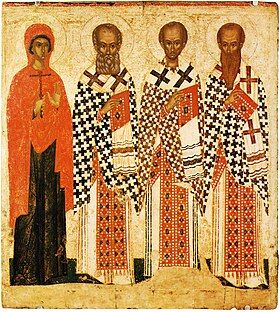Paraskeva of the Balkans
- For other saints named Paraskevi or Parascheva, see Saint Paraskevi.
Saint Paraskeva of the Balkans | |
|---|---|
 | |
| Born | Epivates |
| Died | 11th century Katikratia |
| Venerated in | Eastern Orthodox Church |
| Major shrine | Metropolitan Cathedral of Iaşi, Romania |
| Feast | October 14 |
| Patronage | embroiderers, needle workers, spinners, weavers, marriage[1] |
Saint Paraskeva of the Balkans (also known as Sveta Petka, Petka of Bulgaria, Petka Paraskeva, Paraskevi of Serbia, Paraskeva Pyatnitsa, Parascheva of Tirnovo, Paraskeva the Serbian, Paraskeva of Belgrade, Parascheva the New, Parascheva the Young) was an ascetic female saint of the 11th century. She was born in the town of Epivates (close to today's Istanbul) on the shore of the Sea of Marmara; her parents were wealthy landowners.[1]
The legend says that when she was 10 years old, Paraskeva heard in a church the Lord's words: "Whoever wants to come after Me, let him deny himself, and take up his cross, and follow Me." (Mark 8, 34). These words would determine her to give her rich clothes away to the poor and flee to Constantinople.[1] Her parents, who did not support her decision to follow an ascetic, religious life, looked for her in various cities. Paraskeva fled to Chalcedon, and afterwards lived at the church of the Most Holy Theotokos in Heraclea Pontica.[1] She lived an austere life, experiencing visions of the Virgin Mary. Her voyages took her to Jerusalem, wishing to spend the rest of her life there. After seeing Jerusalem, she settled in convent in the river Jordanian desert.
When she was 25, an angel appeared in her dreams, telling her to return to homeland. She returned to Constantinople, and then when she was 25, lived in the village of Kallikrateia, in the church of the Holy Apostles. She died at the age of 27.
Veneration
Christian tradition states that after an old sinner was buried near Paraskeva’s grave, the saint protested by appearing in a dream to a local monk. The vision informed the monk where the saint had been buried; when the body was unearthed, it was found to be incorruptible.[1] The relics were translated to the church of the Holy Apostles in Kallikrateia.[1]
Paraskeva’s cult and attributes became confused with that of other saints with the same name as well as pre-Christian deities of the Slavs.[2]
As one scholar asks:
Was Parasceve, or Paraskeva, an early Christian maiden named in honor of the day of the Crucifixion? Or was she a personification of that day, pictured cross in hand to assist the fervor of the faithful? And was the Paraskeva of the South Slavs the same who made her appearance in northern Russia?[2]
The cults of Paraskevi of Iconium (Paraskeva-Pyatnitsa) and Paraskeva of the Balkans were conflated with that of a Slavic deity associated with Friday, alternatively known as Petka, Pyatnitsa, or Zhiva.[3][4][5] Attributes, such as the association with spinning, were also merged into the cult of these saints.[3]
Relics

In subsequent years, Paraskevi’s relics were translated to various churches in the region.[1]
In 1238, the relics were translated from Kallikrateia to Veliko Tarnovo, capital of the Second Bulgarian Empire.[6]
In 1393, they were translated to Belgrade,[6] specifically the Ružica Church. When Belgrade fell to Ottoman forces in 1521, the relics were translated to Constantinople. In 1641, the relics were translated to Trei Ierarhi Monastery, in Iaşi, Romania. In 1888, they were translated to the Metropolitan Cathedral of Iaşi.[1]
A severe drought in 1946-47 affected Moldavia, adding to the misery left by the war. Metropolitan Justinian Marina permitted the first procession featuring the coffin containing the relics of Saint Paraskevi, kept at Iaşi since then. The relics wended their way through the drought-deserted villages of Iaşi, Vaslui, Roman, Bacău, Putna, Neamţ, Baia and Botoşani Counties. The offerings collected on this occasion were distributed, based on Metropolitan Justinian's decisions, to orphans, widows, invalids, school cafeterias, churches under construction, and to monasteries in order to feed the sick, and old or feeble monks.[7]
Iasi Pilgrimage
Pilgrimage at the shrines located in the Metropolitan Cathedral of Iaşi has become one of the major religious events in Romania. Hundreds of thousands of pilgrims gather each year in Iaşi in the second weekend of October to commemorate St. Paraskeva, while the city itself established its Celebration Days at the same time.
Noteworthy churches dedicated to St. Parascheva
- Metropolitan Cathedral, Iaşi, Romania
- Church of St Paraskeva, Sofia, Bulgaria
- Church of St Petka of the Saddlers, Sofia, Bulgaria
- Church of St Petka, Ruse, Bulgaria
- Church of St Petka, Vukovo, Bulgaria
- Church of Pious Paraskeva, Desești, Romania
- Church of Saint Paraskevi, Paloumba, Greece.
- Church of Pious Parascheva, Poienile Izei, Romania
- Wooden Church of Saint Paraskevi of Serbia (1820) with a belfry in Bohorodchany Raion, Ukraine
- Church of St Petka, Belgrade, Serbia[8]
- Church of St Petka, Dubica, Bosna i Hercegovina
- St. Petka's Church, Banovci, Croatia
- St. Paraskeva Church, Lviv, Ukraine
- http://sv-paraskeva.if.ua Church of St. Paraskevia , Ukraine, Ivano-Frankivsk, Opryshivtsi
References
- ^ a b c d e f g h "Saint Petca Parasceva". Patron Saints Index. 2010. Retrieved March 31, 2010.
- ^ a b Nicholas Valentine Riasanovsky, Gleb Struve, Thomas Eekman, California Slavic Studies, Volume 11 (University of California Press, 1980), 39.
- ^ a b Joanna Hubbs, Mother Russia: the feminine myth in Russian culture. Volume 842 of Midland Book (Indiana University Press, 1993), 117.
- ^ Boris Rybakov. Ancient Slavic Paganism
- ^ Boris Rybakov (2010). "Ancient Slavic Paganism". Bibliotekar. Retrieved April 1, 2010.
- ^ a b "St. Petca-Parasceva". Orthodox America. 2010. Retrieved April 1, 2010.
- ^ "Dobrogea". Centrul de pelerinaj. 2010. Retrieved March 31, 2010.
- ^ Church of St Petka (Serbian)
